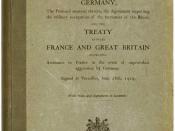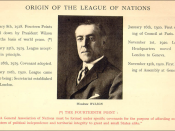Treaty of Versailles 1919
After the armistice of World War I, the Allied powers were left with the task of figuring out the conditions to end the war. Germany would have to agree to whatever the Allied powers came up with, or face the threat of being occupied by Allied powers. Each nation submitted its requests for the Treaty. After compiling each of the nation's requests and cutting some of each nations request, the Treaty was sent to each nation to be ratified. All of the nations involved ratified the treaty except for the US. The Treaty of Versailles was unable to be ratified by the US because President Wilson was unwilling to compromise on the League of Nations.
The US sent President Woodrow Wilson's Fourteen-Point plan for consideration. After most of his fourteen-points were rejected or compromised, the remaining points were incorporated into the Treaty of Versailles, and the Treaty of Versailles was sent to the US to be ratified.
One of Wilson's Fourteen-Points was the idea for a League of Nations, which was included in the original Treaty of Versailles sent to the US. This "league" would include most of the nations in the world, and would decide conflicts between nations. This article was the article that the US Senate could not agree upon
During the time of the Senate negotiations, three groups existed. The first was strongly in support of the Treaty with the League of Nations. The second would have supported the treaty with modifications. The third would not support the treaty with the League of Nations in it at all. The main chunk of votes, however, lied in this second group. As supported by William Borah's speech, there was a group of senators who did not support the League. They did not want the...


